French fries have become one of most Americans’ favorite culinary inventions. The “French” part of the word derives from the way potatoes are cut, as a “French cut” refers to slicing something into thin strips.
Aside from the fact that many of us avoid potatoes and fast food restaurants like the plague (myself included), fries are still very appealing, and I don’t see why we shouldn’t satisfy our cravings. All we need to make quality fries in our own home is a starchy vegetable, a sharp knife or mandolin, parchment paper, some oil & salt, and a really hot oven.
Heck, if you’ve got those things, you’re only thirty minutes away from the best darn fries you’ve ever had!
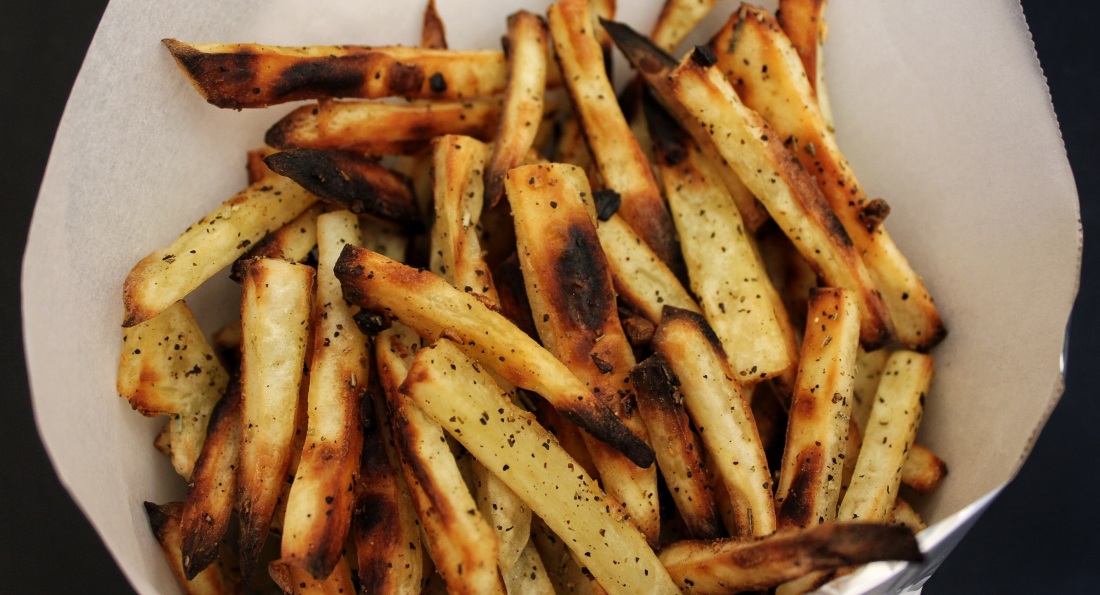
First off, the vegetable we choose is crucial to our success. I’ve tried several things: purple sweet potatoes, orange sweet potatoes (garnet and jewel varieties), and yucca root, but by far, the best fry fodder I’ve found is a white or Hannah sweet potato.
Hannah sweet potatoes are starchier than the popular orange varieties, making them firm like russet potatoes and subtly sweet, like other sweet potatoes. They’re perfect for making french fries because they hold their shape when baked at high temperatures, allowing their outsides to become crispy without their insides turning to mush – a problem I’ve had with jewel and garnet sweet potatoes.
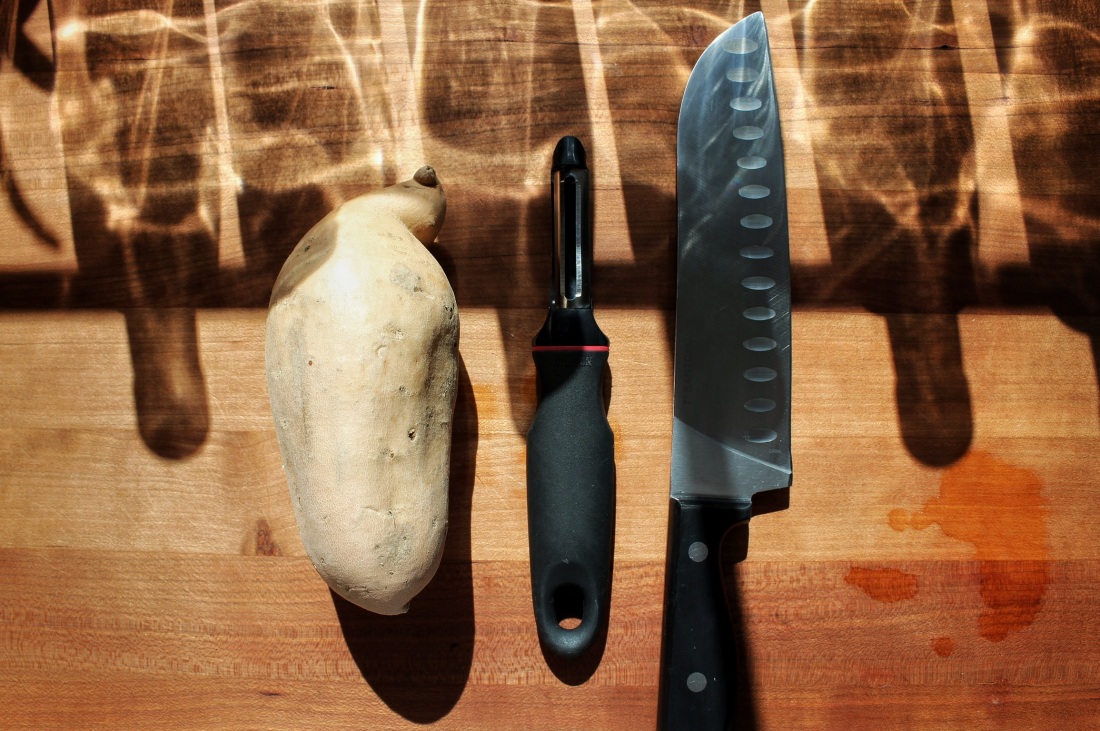
I understand that disassembling a big ‘ole hunk of root vegetable may seem like a daunting task, but there’s nothing to fear if you have a sharp knife or mandolin nearby. My whole life, cutting sweet potatoes has been a real bitch (pardon my french… bad pun intended), up until recently when Kim and I got our knives sharpened. Suddenly, breaking down a sweet potato into thin strips is a breeze.
Alternatively, for a more mechanical option, you can use a mandolin fitted with a french fry slicer attachment, which produces thin, consistently sized fries. However, we tend to stick to knives for this job, as a semi-experienced knifeman (or woman) can convert a large sweet potato into french fries within a couple of minutes.
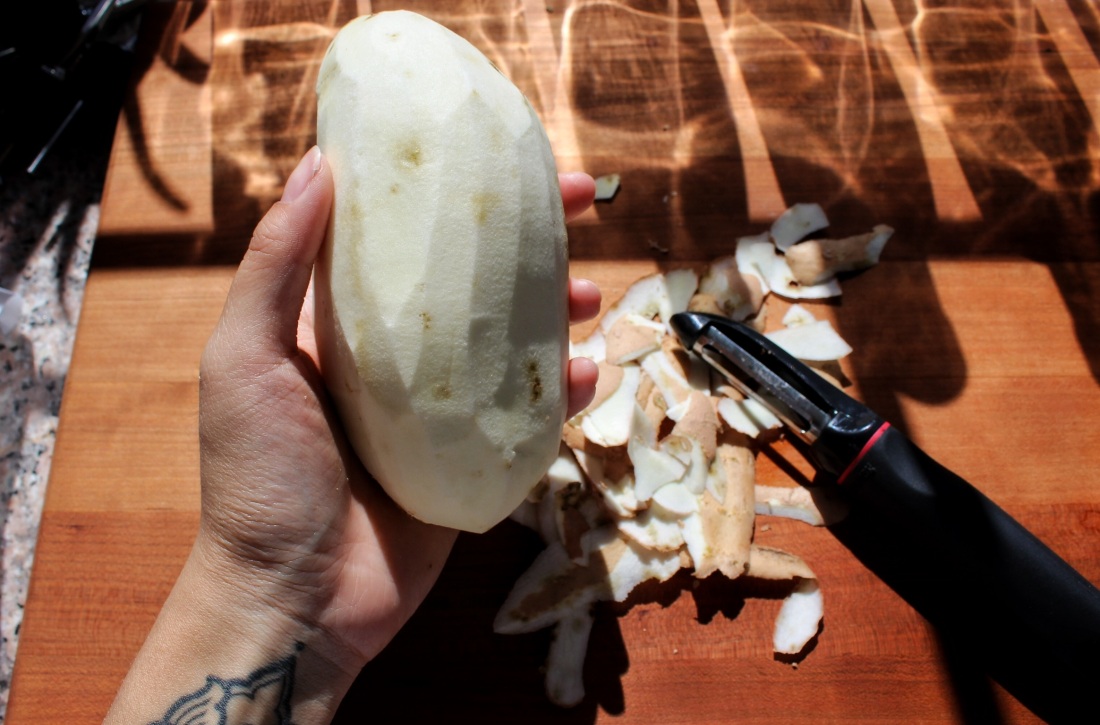
Parchment paper is an important element when baking one’s own sweet potato fries, as it wicks excess away moisture from the fries, which results in a crisp end product. A bare pan or aluminum foil, on the other hand, will hold moisture right against the surface of the sweet potato, which makes for soggy fries… no thanks.
A fair amount of oil will not only enhance browning, but it will act a barrier between the moisture inside our fries and the intense heat of the oven; oil will keep moisture inside the sweet potato, making for a tender interior and crispy exterior. Oil also helps seasonings adhere to fries.
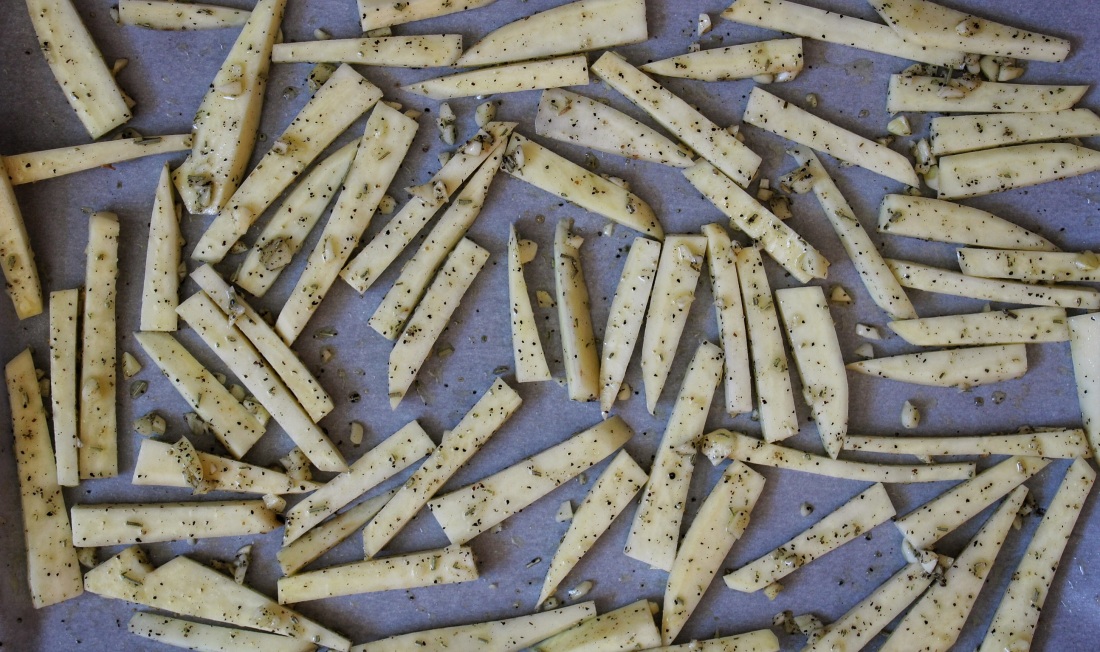
In coordination with oil, salt will bring moisture to the surface of the fries. The mixture of moisture and oil will create a crisp, brown crust on the surface, which is recognizable by the sound of sizzling in the oven. Thus, even though the oven’s used as our heating method, these fries are still “fried,” only with way less oil and clean up than traditional deep frying.
While we have a glue that spices and herbs can stick on to – a.k.a. olive oil – let’s add some additional flavors. Fresh garlic, dried rosemary, and black pepper add classy pizazz without overpowering the subtle sweetness of the sweet potato.
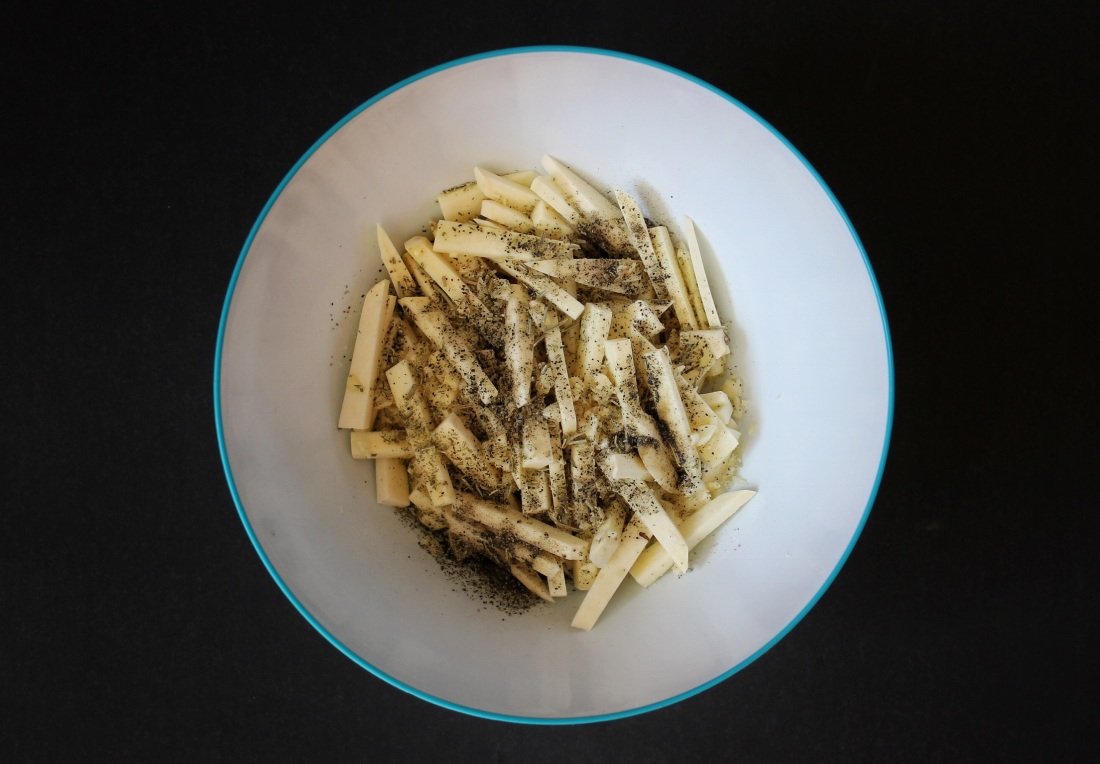
Adding to the flavor dynamic, half of the garlic will stick to the fries, while the other half will fall off, burn, and turn into a crispy treat to enjoy with your fries. Burnt food may not be avant-garde, but that doesn’t mean its contribution to certain foods should go unnoticed.
Lastly, temperature is the most important ingredient in these fries. If you take away nothing else from this post, remember this: Hotter Oven = Crisper Fries. For me, that means cranking my oven as high as it will go, which is 500° F. However, if your oven can reach 600° F, that would likely create an even crisper fry. I’ve tried my hand at making fries in a 400° F oven many times, but the results are always lackluster.
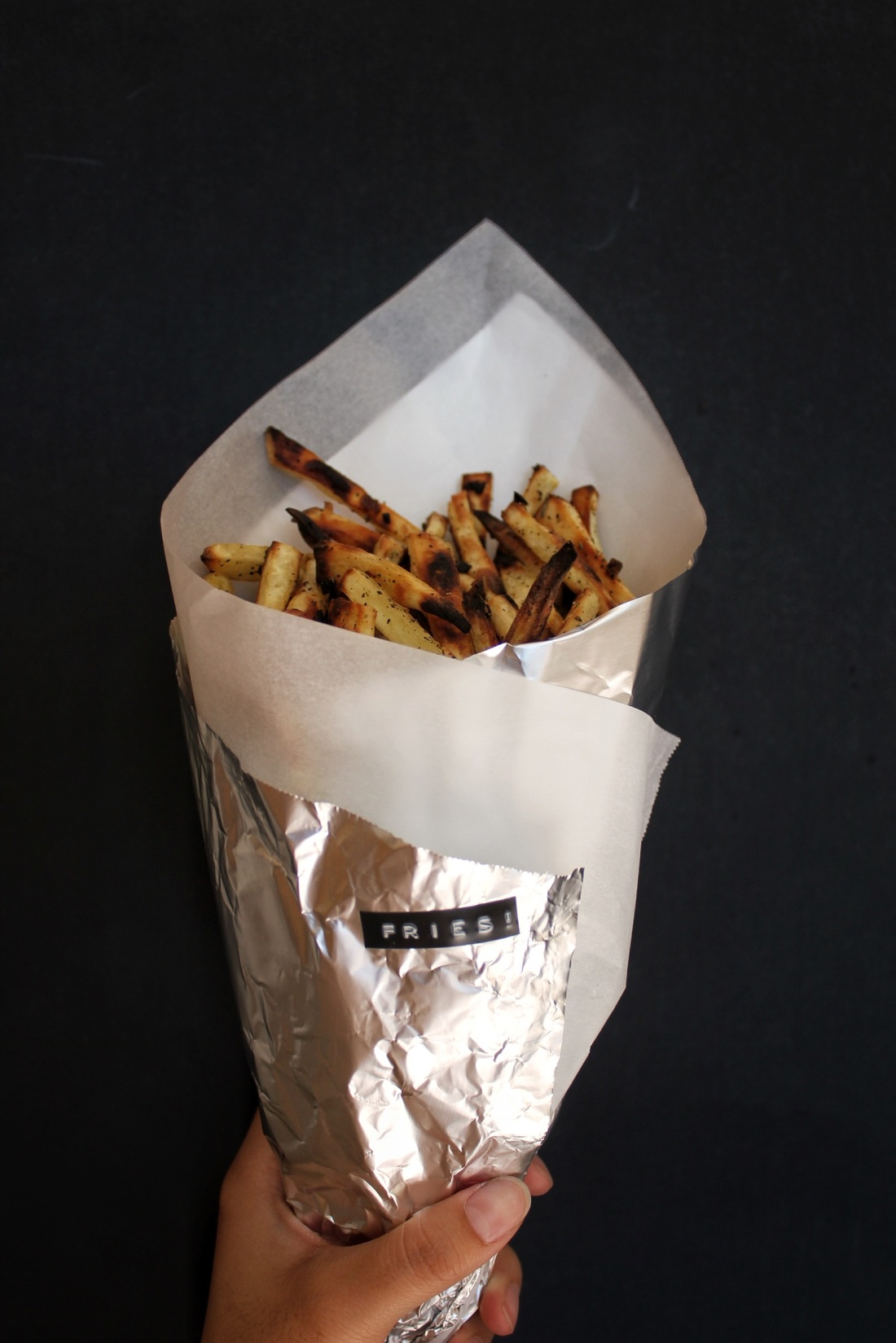
Despite their complete monopolization from the commercial food industry, quality french fries are a darn good – and healthy – snack that can be made in your own kitchen in less than 30 minutes. Just remember: line your pans with parchment paper, use the right kind of sweet potato, don’t skimp on the oil & salt, and crank your oven to nuclear.
If you like what your taste buds are tellin’ ya, leave behind a nice rating, share your thoughts with us in the comments, or show us your creations by tagging @noeggsorham on Instagram.
All the best,
Kim & Ryan
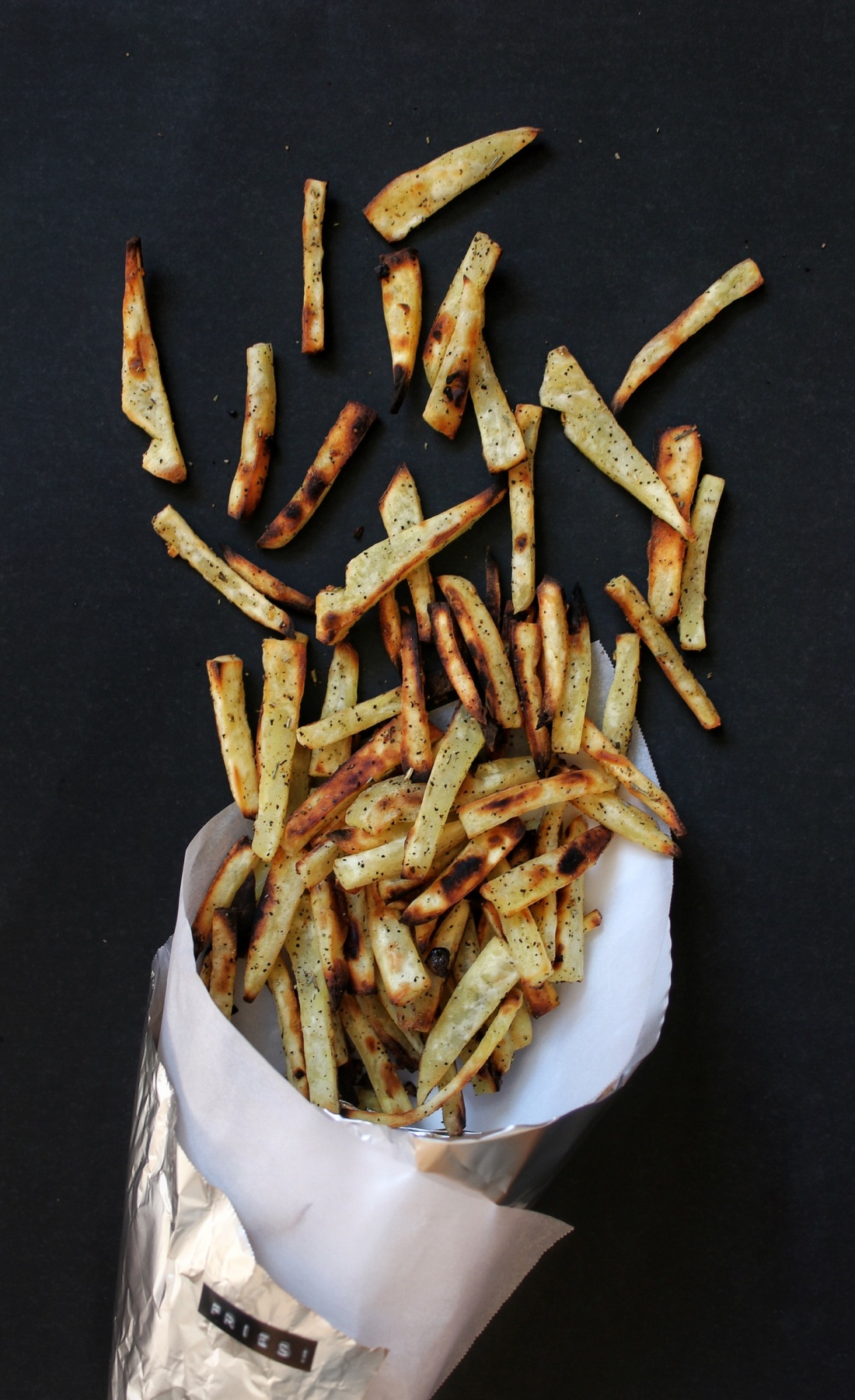
Crispy Baked Rosemary Fries
Garlic & rosemary seasoned white sweet potato strips baked in a blazingly hot oven.
Ingredients
- 1 medium white or Hannah sweet potato, cut into uniform, thin strips (peeling is optional)
- 2 tbsp olive oil
- 2 tbsp finely minced garlic (about 4 large cloves)
- 1/2 tsp dried rosemary
- 1/2 tsp sea salt
- 1/4 tsp black pepper, finely ground
Directions
- Pre-heat oven to 500° F and line two cookie sheets with parchment paper.
- Toss together all of the ingredients in a large bowl until spices are evenly dispersed.
- Distribute fries among prepped cookie sheets, ensuring that every fry has empty space around it on the pan. Cluttering the fries together during cooking will result in a soggy end product.
- Place fries on separate racks in prepped oven for 6 minutes. Remove pans, stir up fries, and place back in oven – this time with the bottom pan on top and vice versa – for another 6 minutes.
- Check to see fries are fork tender. If so, you can remove them at this time, or you can place them back in the oven for 2-3 more minutes to make them extra crispy.
- Serve immediately!

So how on earth do you use parchment paper in an oven cranked to 500 degrees or higher? In my universe, paper burns at 451. (Easy to remember because of the book!) Even when I use parchment paper at 450 in my oven, the edges come out burned away even if I never see a flame. I have to imagine at 500 the paper would be decimated.
LikeLike
Haha, so I’ve actually recently started switching over to aluminum foil on higher temp recipes for that very reason! However, if the ingredients are packed on heavy, the parchment won’t burn nearly as much, but if there’s a lot of space in between ingredients, it will totally burn. Also, I never correlated 451 F with being the temperature in which paper burns. The more you know!
LikeLike
OMG, your photos are amazing!
I’ll follow your recipe, it looks delicious 😋
LikeLike
These look delicious, I will have try this. The ONLY knife I will use for cutting sweet potatoes (because they really are a capital B) is my Sanko…believe it or not, my hubby got this for me from Walmart a couple years ago solely because it’s purple…my favorite color. Best. Knife. EVER.
LikeLike
This looks amazing Kim & Ryan – can’t wait to give it a go! Hopefully mine will turn out crispy ;-)
LikeLike
Best of luck! Let us know how they turn out.
LikeLike
I love rosemary everything.. these fries… yum!
LikeLike
I LOVE this post. Such great detail, and these fries sound amazing. I can’t wait to try this on my own. :)
LikeLike